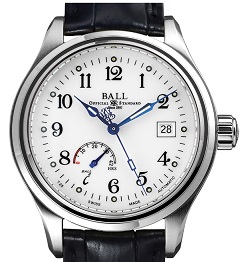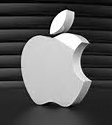WATCH ANATOMY
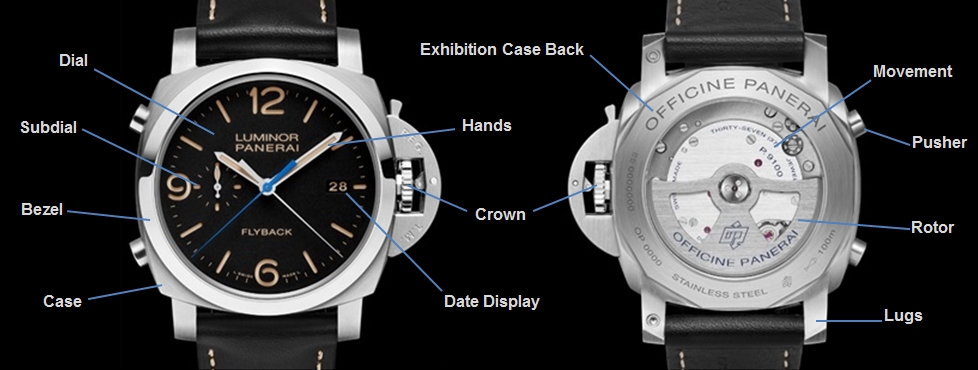 |
|
HOROLOGICAL TERMS
Case: Consisting of a watch's middle, bezel, and back, it protects and houses the movement inside. It can be made from different metals and in different shapes. The examples below illustrate common case shapes currently being produced
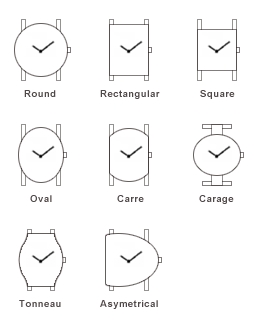 |
|
Hands: The hands on a watch indicate either the hour, minute, or second, along with other functions. Often taking their cues from the general aesthetic of the watch, the hands can vary in shape, size and style.
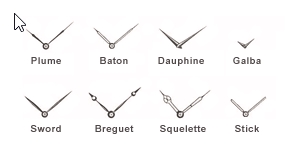 |
|
Dial: The dial is the face of the watch. There are many ways a dial can be marked. The examples below show some of the most popular dials.
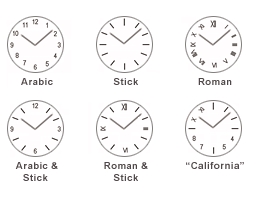
Movement: The movement is the engine of the watch; it makes the watch work. The different types of movements and the importance of their functionality are explained in greater detail in the Movements section.
Exhibition Case Back: A case back to show off movement finishing and craftsmanship. Ideal for anyone who appreciates the intricate inner-workings of a timepiece, an exhibition back displays the mechanical workings of a watch.
Rotor: In automatically winding timepieces, the rotor's partial or complete revolutions work in conjunction with the movements of the human arm. The rotor turns freely in both directions to wind the mainspring, which stores and transmits the energy that powers your watch.
Lug: A case attachment, the lug allows for a strap or bracelet to be attached to the watch case. Ensures that your ticker isn't going anywhere you don't want it to.
Hour Marker: An hour indicator applied or painted on the dial of the watch.
Subdial: A small dial set within the main dial, used to display an additional complication such as Chronograph readout, seconds, or date.
|
|||||
|
"Blued Steel" hands are dark navy in color; a result of super heating steel until the color changes. This was first used by the famous watchmaker Abraham-Louis Breguet in the 19th century to help make the hands more legible
|
|||||||||
|
|
|
|
|
||||||
|
Crystal: The Crystal is a 'glass' covering the dial or 'face' of the watch, protecting it from dirt and water. There are three major types of crystals produced and used in watch making.
Synthetic Sapphire: This transparent, lab grown element has exactly the same chemical composition as natural sapphire. Sapphire ranks a 9 on Mohs' hardness scale. It is the most expensive type of crystal and the majority of watches imported from Switzerland contain them.
Mineral: Mineral crystals are made of glass. Mineral crystals are a 7 on the Mohs scale of hardness. They are inexpensive compared to sapphire crystals, usually costing less than one hundred dollars to replace if damaged.
Acrylic: Acrylic is the most affordable type of crystal. It can be easily polished to remove light scuffs.
|
|
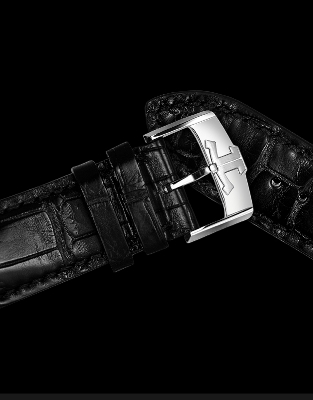 |
Buckle (Tang Buckle): A traditional buckle in which one end of the strap is slipped through a buckle with a pin used to secure the fit of your watch.
|
|
|||||
|
|
|||||||||
|
Crown: Connects to the internal movement of a watch through the case, the crown, which can vary from a simple gasket to an intricate system of screws, allows you to wind, hand-set, and employ special functions like date settings and time.
Screw-down Crown: A crown which aids water resistance by sealing it against the case. The seal is achieved through gaskets and by matching the threaded pipe on the case with the crown's internal threads, while twisting the crown to lock it into place.
|
Deployant Buckle: A deployant, or fold-over clasp, is an elegant flourish that allows for perfect strap closures through interlocking metal pieces, eliminating the need for strap holes. It is considered safer to wear than a regular Ardillon buckle. If the buckle should happen to open up, the watch is still attached to the wrist.
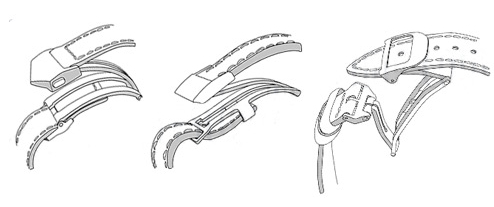 |
||||||||
|
|
|
|
|
|
|
||||
|
|
Pusher: Otherwise dubbed a 'push-piece' or a 'push-button', this handy mechanical element is mounted on a watch's case to control specific functions, such as timing functions in a chronograph.
|
|
|
||||||
|
|
|
|
|
||||||
|
|
|
|
|
||||||
|
|
|
|
|
|
|||||
|
|
|
Bezel: The bezel is either snapped or screwed into the case and often holds the crystal, the protective covering of the watch, in place. Bezels can be functional for diving and timing or purely aesthetic, as with a diamond set bezel.
|
|
|
|||||

